Despite all the ongoing debates on email marketing’s effectiveness, marketers continue to hail it as one of the best strategies to drive higher ROI. What has really changed in email marketing is how it is being done now. Emails have become more like one-on-one communication between the brand and the customer. It is targeted, personalized, and designed to trigger engagement. In fact, marketing emails are pre-scheduled based on various behavioral triggers.
However, in the present date, the debate of email marketing’s effectiveness has shifted base to email marketing vs. social media marketing. In a survey by Ascend2 last year on effective tactics used in digital marketing, email marketing is ranked fifth after SEO, marketing technology, content marketing, and social media marketing. The report may look surprising, but smart marketers have already worked around it. Rather than judging which ranked where, marketers started merging social media marketing (more specifically, Facebook ad marketing) with email marketing.
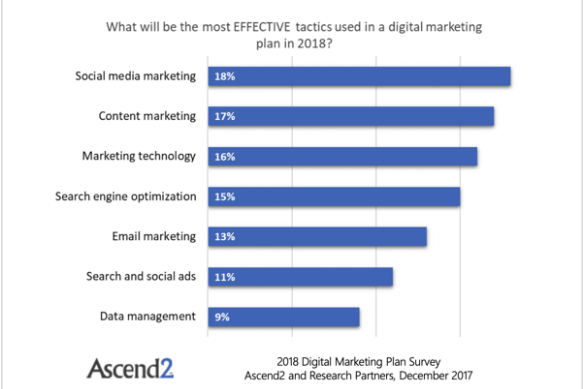
Why email marketing and Facebook ads need to be synced?
Let’s just be honest here. Social media marketing’s lion’s share belongs to Facebook. Since Facebook is urging marketers to drive business through Facebook ads (and the world’s majority population is on Facebook) marketers are leaving no stone unturned to tap into every possible potential this platform offers.
Facebook ads are targeted and can help you narrow down your target audience as well as using various audience filters. Also, this platform offers better chances of engagements and clicks.
Now let’s look at email marketing. An email marketing campaign is successful when you have a healthy email list of subscribers who are genuinely interested in your brand. This means, you need to first generate leads, for which usually you build a landing page. Here’s the important fact check now: Social media platforms excel at landing pages.
Add to this, you have a better scope of promoting your content offers on social media platform where a massive and diverse user base is engaging day-in-and-out. In fact, Facebook ads are a great means of driving traffic to your dedicated landing page where they can opt-in to your email lists.
Another important fact is, Facebook ads often lead users to connect with the brand directly on Messenger to ask for offers and other information. A Facebook Messenger bot in this instance plays a crucial role in interacting and engaging with the user. Once a user starts interacting with your Messenger bot, you continue sending out relevant information from time to time unless they manually tell you to STOP. In fact, these bots kind of capture lead information from the user’s social profile. Later, this information can be used for retargeted ads, progressive profiling, and finally email subscriptions.
So, you see, it is a chain of activities that are inter-dependent on each other. If you are tying your Facebook ad marketing with email marketing automation, you can drive better ROI. Let’s explore in detail how:
Facebook email marketing and its impact on conversion rates
P.S. Facebook email marketing definitely does not mean “sending emails from Facebook”. I couldn’t help but write this because I did hear one of my peers say so! It is NOT.
Merging email campaigns with Facebook marketing can help you attain and retain customers. Before I tell you how, here’s a heads up:
If you are using a marketing automation tool (which I am so sure you are), make sure your tool offers Facebook custom audience sync feature so that you can sync your segments with the Facebook audience and vice-versa. This gives an added advantage in designing a relevant email campaign.
Coming to how Facebook email marketing impacts conversions for a brand, here we go:
(1) Re-engage and convert inactive subscribers
Facebook ads can help you re-engage your inactive subscribers and push them towards conversion. Many subscribers stop engaging suddenly while many don’t engage at all even after subscribing. This is one challenge email marketers continue to face.
Human brains react to something they are curious about or something that they are aware of. Hence, people will click on something that creates curiosity or on something they are familiar with. Here is where Facebook ads step in as a mid-way. Facebook ads are targeted and filtered based on age groups, demographics, interests, etc. So, when a user sees a relevant ad that relates to their interests, they tend to click on it. This takes them to a landing page where they subscribe to receive updates. Now when they receive an email on the same subject, they immediately relate to the ad that led to the email.
Let’s take an example. I am a traveler. Although I have not traveled in months, it does not stop me from planning multiple trips which means I am browsing travel portals. To some, I subscribed, to some I didn’t. And then I forgot. I don’t even open their emails most of the time. Recently, the travel hang-over was back and I was browsing again. In about a day’s time, I started seeing ads related to traveling and bookings. While I consciously ignored most, this particular remarketing ad had me hooked.
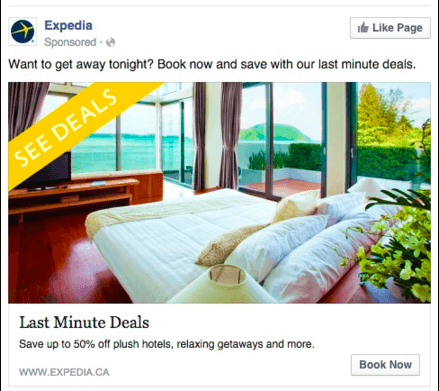
I had already subscribed to Expedia but I don’t think I opened any of their emails after the ‘welcome’ email. After a point, my non-engagement resulted in zero emails. This ad, however, made me click to ‘see the deal’ and snap, I was back on their email list for ‘active users’ or probably ‘interested users’. This time, their emails were related to this offer in the ad making it easy for me to transit from Facebook ad to emails. Probably, the next day, I received an email on daily deals which was live for 24 hours only. I quickly clicked to see what deals were available.
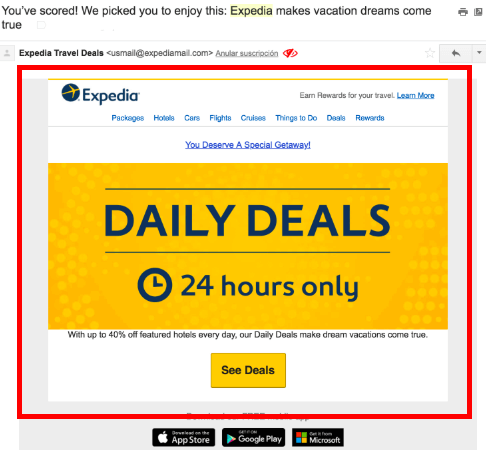
The line “24 hours only” was enough to trigger me because I wanted to make a booking this time, given my travel plans were on hold for so long. The FOMO in marketing is one great way to get subscribers active once again. However, the catch is to know when!
PS: As a matter of fact, I did end up booking the hotel from Expedia after browsing through their daily deals and getting the email on the same..
(2) Nurturing anonymous users and building email lists
Facebook Messenger Bots are another instance of how brands are merging Facebook marketing with email marketing. Facebook quickly picked up on the trend of ‘chatting’ and introduced Bot API for brands to interact with their user base on Messenger real-time. Brands took this opportunity to nail Facebook Messenger Bots and trigger user engagement (And conversions).
Almost all brands looking to make a strong digital footprint are adopting a marketing automation tool with multichannel and omnichannel functionalities. These brands sync Facebook Messenger with their automation campaigns. How? Using custom audience sync, they start showing relevant ads to their target user base and encouraging them to start a conversation over Messenger. Once they do so, these users are added to the segment “Facebook Messenger Leads”. Several automation tools have features like autoreplies, auto comments, auto following which helps in progressing the conversation. As and how the conversation proceeds and (if) the user gives out their email addresses, they are then segmented for email automation campaigns. Of course, their behavioral pattern and interests play a pivotal role in deciding which segment they will get added to.
For instance, below is my first conversation with The Wall Street Journal’s Messenger Bot. My preferences were noted down and automatically I was shown news related to the same.

I enjoyed reading the news. I had so many options to pick from. I could opt for Podcasts or plain text news. However, every time I opened a news article, I saw this pop-up:
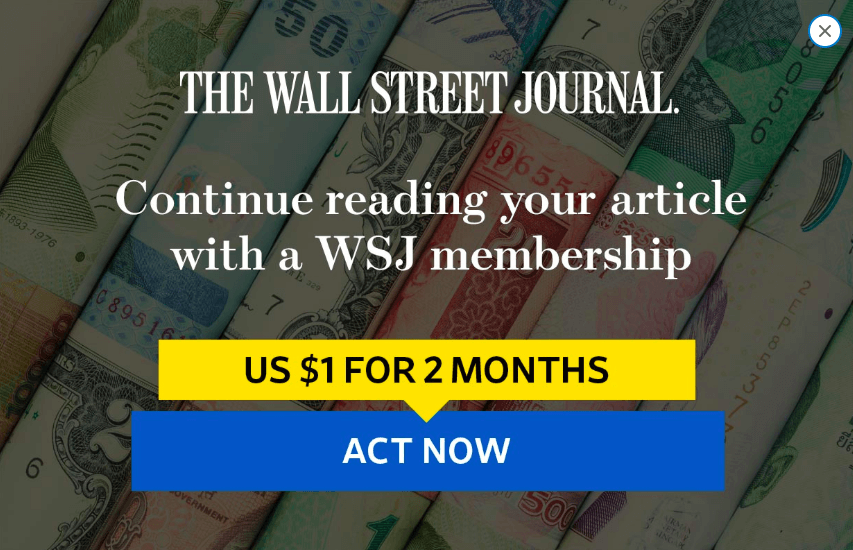
I ignored it a couple of times.
But that wasn’t for long. When I realized I had to wait on the Messenger Bot every time I wanted a news feed, I was keener to get it all delivered to my mailbox. And that’s how I ended up “acting now” on The WSJ.
Here you can see; I became a paid member of The WSJ at the end of the tunnel.
[Also, because there was a Summer Sale I could avail].
Here’s the landing page I saw where I was to first create an account, then add my billing address, and finally become their customer. Since I had the option to cancel for free anytime, I jumped in.
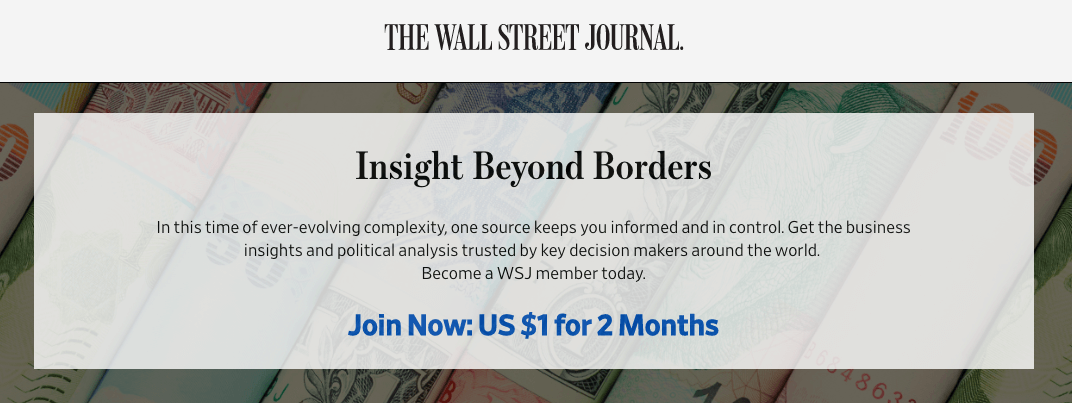
Below is my first email from The WSJ upon being a member:
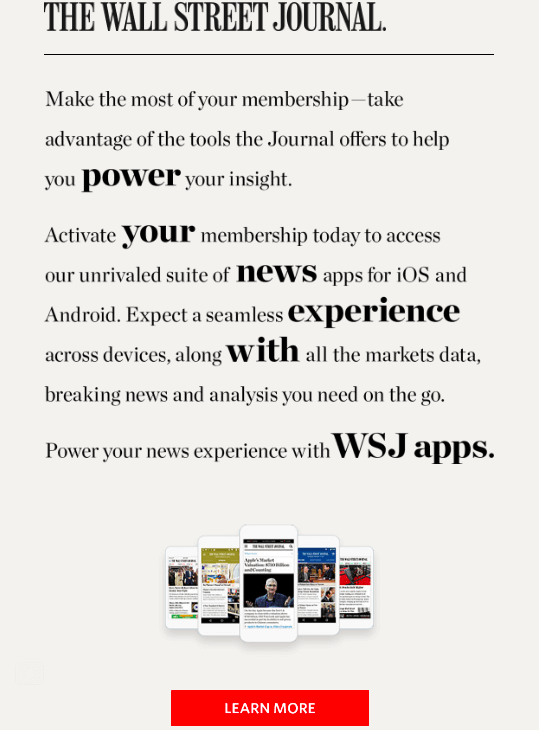
(3) Direct conversions, without a bot
While The WSJ had a bot in play, here’s another instance of how Facebook ad can trigger direct conversion into a customer:
For example, I am always fascinated with animated videos that brands use as explainer videos. Recently, we were in a discussion of doing one for our brand, Aritic. So, I set off looking for creative people who can help me get this done or maybe a platform that will fit our budget. That’s when I came across this ad from Toonly.
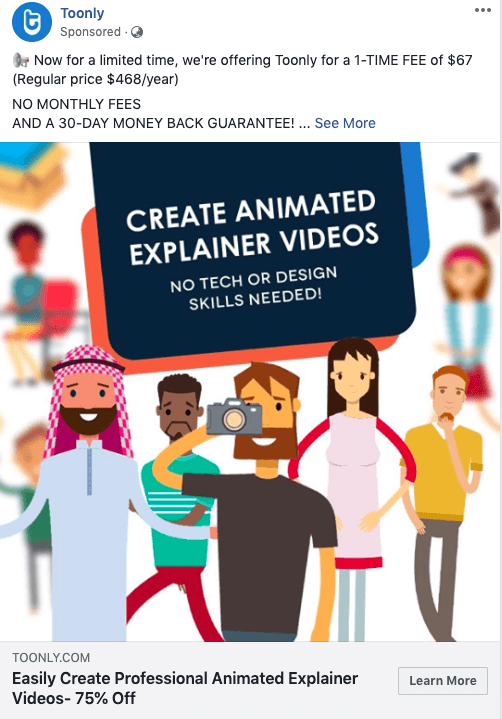
Honestly, I have never heard of them nor have I ever visited their platform before bumping on this ad. Their ad tagline caught my attention. Since we were also looking for ‘budget-friendly’ options, Toonly looked a good offer.
This is how their landing page looked like:

A FB-only discount sounded just about perfect.
What does all of this mean?
The bottom line here is that Facebook ads and email marketing together can increase your chances of conversion. It impacts your conversion rate positively. Facebook ads help in building email lists that are genuine, these ads are targeted and personalized making it easier to transit from Facebook to emails. Also, the brand awareness goal is successfully met as Facebook ads act as an opener and emails form the base of the relationship.
And I am not saying just like that. A U.S. retailer did see 22% more purchase hits after targeting 565,000 subscribers with regular emails and coordinated Facebook news feed.
Last minute checklist: Things to do
Here are a few things you must be doing to see a positive impact on your Facebook-email conversions:
(1) Build a custom audience including additional data like a specific Facebook event or linked Instagram account along with demographics, age groups, professions, and interests.

(2) Design a dedicated landing page for your leads to convert from your ad into email subscribers. Don’t push them to your website. That’s not where they want to be. They see an ad, the next thing they should see is a landing page built exactly synonymous to the ad with a quick option to subscribe. Your website may turn them away with a host of information. For instance, once again, check this landing page from Toonly (I loved it). Also, make sure to build a landing page without any errors.
(3) Avoid distractions in your ad. Your ad should be neat. So neat that the focus message is clear and sound. Avoid unnecessary design elements that may make your ad look clustered. For instance, take a look at this amazingly simple yet powerful ad from Rand Owens.
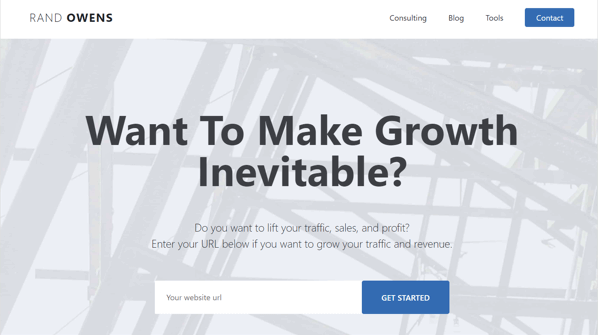
(4) Don’t forget your mobile users. In your bid to master Facebook email conversions, don’t forget to include your mobile-only users. Your ads should not break when your mobile users see them. Neither should they have a problem accessing your landing page and subscribing from it. You can start with the Google Mobile-friendly test where you can just enter the landing page URL and wait for the evaluation. You know, Google knows it all.

(5) Use Facebook ads to test your email subject lines. Yes, this is one thing you can do. Since ads require short and crisp headlines, you can test your headlines here and use the successful ones for the follow-up email sequences. For instance, we tested this tagline in our ads and saw a good response. So, we used it in our next email campaign sharing the same blog. It worked. 🙂
P.S. It is not a mandatory thing. Key is to keep testing – your landing page, your email content, and all design elements included in the entire campaign.
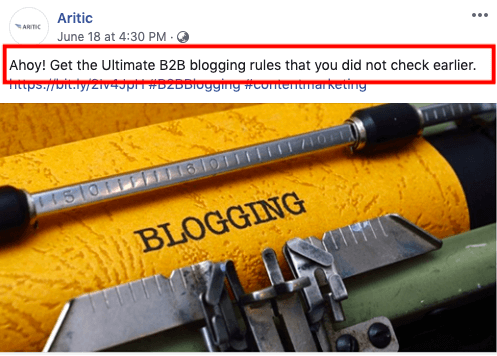
(6) Your drip nurturing sequence must be in place before launching the ad. It must begin with a welcome email and proceed based on behavior and engagement metrics. The segments and email tags should get automatically updated once a contact engages or does a particular action.
In Conclusion
Emails will continue to get more and more personal, and Facebook will continue to stay home to millions of users. If you are not yet merging the two, you are losing out on a massive business opportunity. What do you think of this? Do you think email automation campaigns and Facebook marketing should be merged or not? Feel free to tell your thoughts in the comments below.


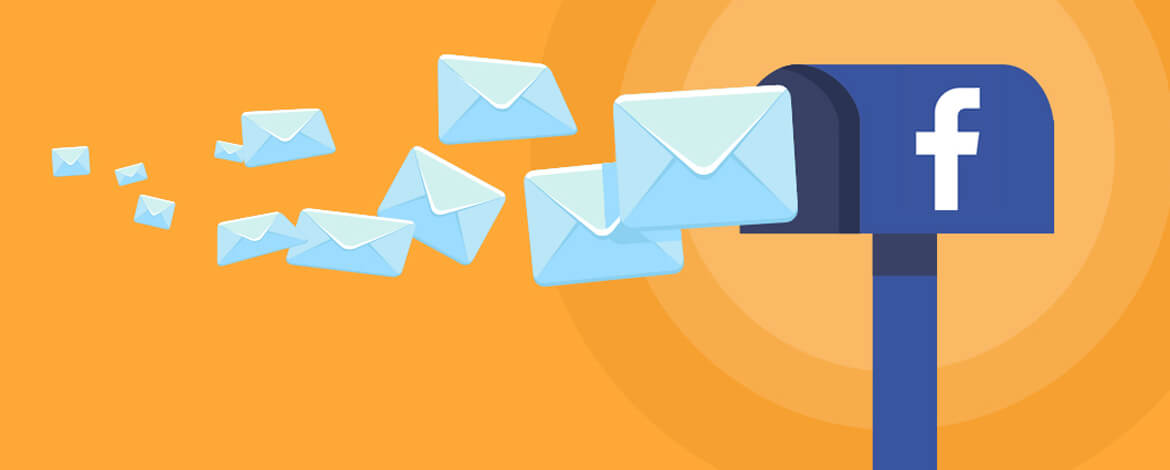





Pritha Bose
Latest posts by Pritha Bose (see all)
How Retention Email Marketing Can Reduce Churn Rate?
Email Campaign Management for Newbies: From Strategy to Deployment